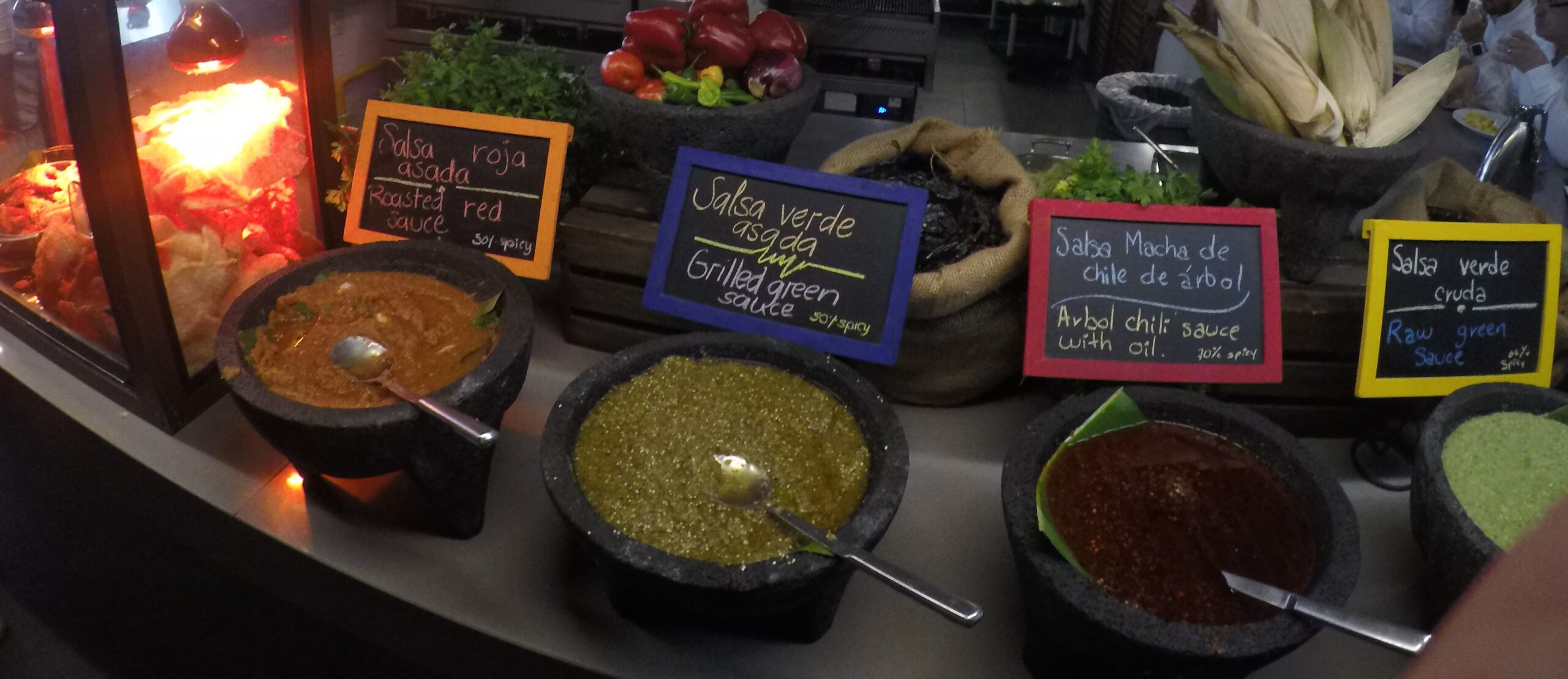Salsas in Mexico have long held a place of honor as a culinary cornerstone of this vibrant and diverse cuisine. During my visit to the enchanting Xcaret Mexico, I was afforded a rare opportunity to immerse myself in the world of authentic Mexican salsas. The array of options was nothing short of breathtaking, with each offering a unique and tantalizing experience. The salsas exhibited a vivid spectrum of colors, reflecting the freshness and liveliness of their ingredients. From palate-tingling spiciness to milder, soothing flavors, these salsas unveiled a taste sensation that transcended any I had encountered beyond the borders of Mexico.
As I delved into this culinary adventure, it became evident that tasting authentic Mexican salsas was far more than a mere gastronomic experience; it was a revelation. Each salsa unleashed a symphony of flavors that danced harmoniously on my palate. The fiery, smoky nuances of the spicier varieties were artfully balanced by the cool, invigorating undertones of the milder ones. It felt as if the very essence of Mexico’s rich culinary heritage had been distilled into these delectable condiments, creating a sensory journey that was both extraordinary and unforgettable.

Most popular varieties of salsas
Pico de Gallo: A quintessential Mexican salsa, Pico de Gallo combines diced tomatoes, onions, cilantro, jalapeños, and lime juice. Its bright, zesty flavors make it a versatile companion to numerous dishes.
Salsa Verde: Made from tomatillos, Salsa Verde packs a tangy punch. Roasted tomatillos, combined with chili peppers, onions, and cilantro, create a salsa that’s wonderfully vibrant and slightly tart.
Salsa Roja: This rich, red salsa is a blend of tomatoes, chilies, garlic, and various spices. Its robust flavor profile, often with smoky or earthy undertones, complements grilled meats and hearty dishes.
Habanero Salsa: For the daring palate, the Habanero salsa offers an intense, fiery kick. Made from the fiery habanero pepper, this salsa is not for the faint of heart.
Chipotle Salsa: Smoked jalapeños, known as chipotle peppers, are the star of this salsa. Their smoky, spicy flavor imparts a distinctive depth to the salsa.
Mango Salsa: A delightful fusion of sweet and spicy, mango salsa combines ripe mangoes with chili peppers, cilantro, and lime juice. It’s a refreshing accompaniment that pairs beautifully with grilled seafood.
History and Importance in Mexican Cuisine
The origins of salsas in Mexican culinary history can be traced back to the ancient civilizations of the Aztecs and Mayans. For these early Mesoamerican peoples, ingredients like tomatoes, chilies, and various aromatic herbs were not just sustenance, but integral elements of their daily diets. The melding of these flavors over centuries led to the emergence of the diverse array of salsas that grace our tables today. In the tapestry of Mexican cuisine, salsas occupy a position of paramount significance. They transcend the label of mere condiments; they are a vibrant celebration of Mexico’s abundant biodiversity and profound cultural heritage. With every spoonful, salsas infuse even the simplest dishes with an explosion of authentic Mexican flavors, creating a symphony for the taste buds.
In Mexican cuisine, salsa plays a pivotal role for several compelling reasons. It is consumed both as a sauce and a dip, offering a versatile accompaniment to a wide array of dishes. Salsa is a flavor powerhouse, with its vibrant blend of ingredients, including tomatoes, chilies, herbs, and spices, adding depth and intensity to dishes, imparting a zesty, spicy, or savory kick that elevates the overall taste profile. Additionally, salsa provides a textural contrast to many Mexican dishes, whether it’s a chunky pico de gallo or a smooth salsa verde, the varying textures complement the textures of other ingredients, creating a dynamic culinary experience. Its presence on the table reflects a tradition passed down through generations, symbolizing the rich culinary heritage of Mexico. Furthermore, salsa’s versatility allows it to complement a wide range of dishes, from tacos to grilled meats and seafood, functioning both as a sauce to coat and as a dip for various culinary delights. While salsa itself is not a complete meal, it does contribute to the overall balance of a dish, with tomatoes and other ingredients offering essential vitamins and antioxidants. The use of fresh ingredients also supports a healthy, balanced diet. Salsa often contains ingredients with high water content, such as tomatoes and cucumbers, contributing to hydration, especially in hot climates. Additionally, the use of fresh, uncooked ingredients maintains their natural flavors and nutritional value. Customization is another key aspect, as individuals can adjust the level of spiciness, acidity, or other flavors to suit their personal preferences, making it a highly adaptable condiment. Finally, sharing a bowl of salsa, whether at a family gathering, a festive celebration, or a casual meal, fosters a sense of togetherness and conviviality, enhancing the overall dining experience by adding an interactive element to the meal. Overall, salsa’s popularity in Mexican cuisine is a testament to its ability to enhance the flavors, textures, and overall dining experience, embodying the vibrancy and depth of Mexican culinary tradition.
Quick and easy recipe for homemade salsa
To make a delicious salsa, start by gathering the following ingredients: 4 ripe tomatoes, 1 small onion, 2 cloves of garlic, 1 jalapeño pepper (adjust to taste), a handful of fresh cilantro leaves, the juice of 1 lime, and salt to taste. Begin by roughly chopping the tomatoes, onion, and jalapeño, and mincing the garlic. Combine these ingredients in a bowl. Next, finely chop the cilantro and add it to the mixture. Squeeze the lime juice over the top and sprinkle with a pinch of salt. Using a spoon, gently toss the ingredients together until well combined. For a smoother consistency, you can use a blender or food processor, but be careful not to over-blend. Taste and adjust the seasoning if needed. Allow the flavors to meld together for about 30 minutes before serving. This homemade salsa is perfect for dipping tortilla chips or as a flavorful topping for tacos, burritos, or grilled meats. Enjoy!
From bustling street vendors to refined fine dining establishments, salsas are an omnipresent force in Mexican gastronomy. They stand as a testament to the boundless creativity and ingenuity of Mexican chefs, who deftly navigate the realms of tradition and innovation. With each new variation and combination, they pay homage to the age-old art of salsa-making while introducing exciting new dimensions to this revered culinary tradition. Experiencing the kaleidoscope of flavors in Mexican salsas at Xcaret was a culinary journey like no other. It highlighted the essence of Mexican cuisine – vibrant, bold, and deeply rooted in tradition. These salsas are not just accompaniments; they are a testament to the heart and soul of Mexican culinary artistry






